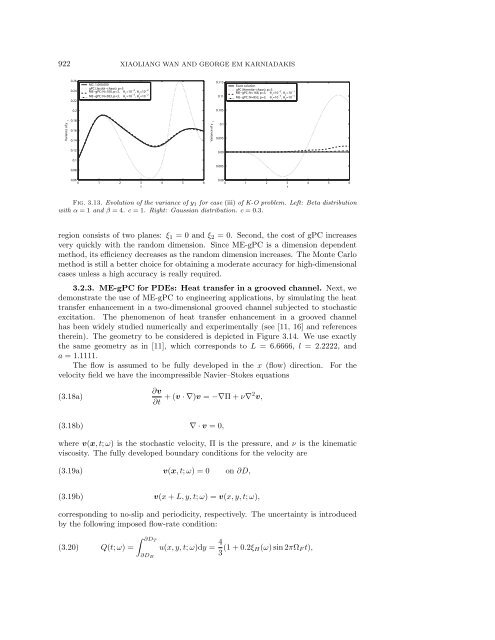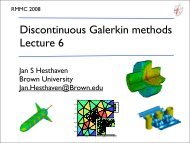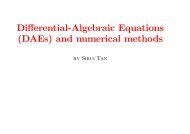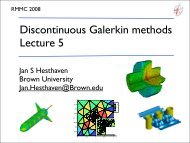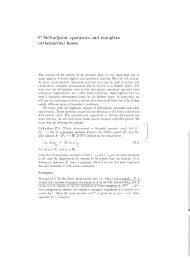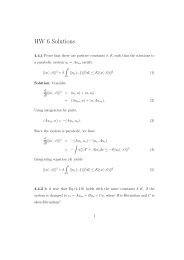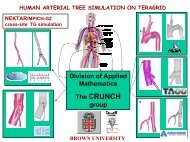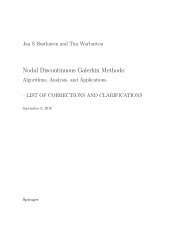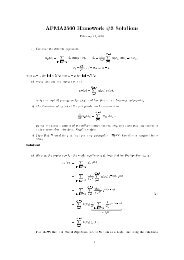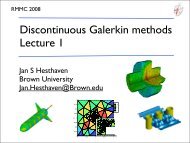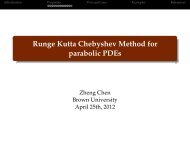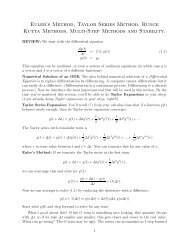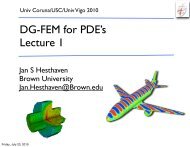MULTI-ELEMENT GENERALIZED POLYNOMIAL CHAOS FOR ...
MULTI-ELEMENT GENERALIZED POLYNOMIAL CHAOS FOR ...
MULTI-ELEMENT GENERALIZED POLYNOMIAL CHAOS FOR ...
Create successful ePaper yourself
Turn your PDF publications into a flip-book with our unique Google optimized e-Paper software.
922 XIAOLIANG WAN AND GEORGE EM KARNIADAKIS<br />
Variance of y 1<br />
0.26<br />
0.24<br />
0.22<br />
0.2<br />
0.18<br />
0.16<br />
0.14<br />
0.12<br />
0.1<br />
0.08<br />
MC: 1,000,000<br />
gPC (Jacobi−chaos): p=3<br />
ME−gPC: N=100, p=3, θ 1 =10 −2 , θ 2 =10 −2<br />
ME−gPC: N=583, p=3, θ 1 =10 −3 , θ 2 =10 −2<br />
0.06<br />
0 1 2 3<br />
t<br />
4 5 6<br />
Variance of y 1<br />
0.115<br />
0.11<br />
0.105<br />
0.1<br />
0.095<br />
0.09<br />
0.085<br />
Exact solution<br />
gPC (Hermite−chaos): p=3<br />
ME−gPC: N=168, p=3, θ 1 =10 −2 , θ 2 =10 −1<br />
ME−gPC: N=852, p=3, θ 1 =10 −3 , θ 2 =10 −1<br />
0.08<br />
0 1 2 3<br />
t<br />
4 5 6<br />
Fig. 3.13. Evolution of the variance of y1 for case (iii) of K-O problem. Left: Beta distribution<br />
with α =1and β =4. c =1. Right: Gaussian distribution. c =0.3.<br />
region consists of two planes: ξ1 = 0 and ξ2 = 0. Second, the cost of gPC increases<br />
very quickly with the random dimension. Since ME-gPC is a dimension dependent<br />
method, its efficiency decreases as the random dimension increases. The Monte Carlo<br />
method is still a better choice for obtaining a moderate accuracy for high-dimensional<br />
cases unless a high accuracy is really required.<br />
3.2.3. ME-gPC for PDEs: Heat transfer in a grooved channel. Next, we<br />
demonstrate the use of ME-gPC to engineering applications, by simulating the heat<br />
transfer enhancement in a two-dimensional grooved channel subjected to stochastic<br />
excitation. The phenomenon of heat transfer enhancement in a grooved channel<br />
has been widely studied numerically and experimentally (see [11, 16] and references<br />
therein). The geometry to be considered is depicted in Figure 3.14. We use exactly<br />
the same geometry as in [11], which corresponds to L =6.6666, l =2.2222, and<br />
a =1.1111.<br />
The flow is assumed to be fully developed in the x (flow) direction. For the<br />
velocity field we have the incompressible Navier–Stokes equations<br />
(3.18a)<br />
(3.18b)<br />
∂v<br />
∂t +(v ·∇)v = −∇Π+ν∇2 v,<br />
∇·v =0,<br />
where v(x,t; ω) is the stochastic velocity, Π is the pressure, and ν is the kinematic<br />
viscosity. The fully developed boundary conditions for the velocity are<br />
(3.19a)<br />
(3.19b)<br />
v(x,t; ω) =0 on∂D,<br />
v(x + L, y, t; ω) =v(x, y, t; ω),<br />
corresponding to no-slip and periodicity, respectively. The uncertainty is introduced<br />
by the following imposed flow-rate condition:<br />
(3.20)<br />
Q(t; ω) =<br />
� ∂DT<br />
∂DB<br />
u(x, y, t; ω)dy = 4<br />
3 (1+0.2ξH(ω) sin 2πΩF t),


